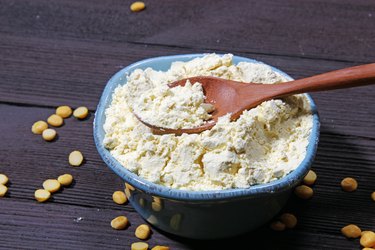
Besan flour, made from chickpeas, is a wheat-free product rich in fiber and nutrients. Found primarily at health food stores in the United States, besan powders can stand in for wheat flour in many recipes, adding a nutty taste to breads, sauces and other foods.
If you have to avoid gluten or are watching your weight, besan, or chickpea flour nutrition makes a healthy and versatile alternative to high-carbohydrate wheat flour.
Video of the Day
Video of the Day
Read more: The Protein in Chickpeas
Besan: Chickpea Flour
Besan flour, also known as gram, garbanzo or chickpea flour, is made by milling chickpeas, a type of legume. It may be either finely or coarsely ground. Cooks in India use a particular type of chickpea called chana dal. Besan flour is pale yellow in color and a staple of Indian cuisine, used to make dumplings, fritters and noodles, and for thickening curries.
Chickpea Flour Nutrition
Besan, or chickpea flour, calories clock in at 356 per cup, according to the USDA. It also has 20.6 grams of protein, 10 grams of sugar, 6.1 grams of fat, 9.9 grams of fiber and 53.2 grams of carbs in besan. A third of the starch in besan is amylose, a slowly digested starch that helps you feel full longer, according to an October 2013 review published in Critical Reviews in Food Science and Nutrition.
A 1-cup serving of besan is rich in the minerals calcium, magnesium, potassium, zinc, iron, phosphorus, manganese, selenium and copper. Although not a rich source of most vitamins, besan does contain vitamin A, niacin, pantothenic acid, vitamin K and folate.
Read more: Are Chickpeas Good for Weight Loss?
Health Benefits of Besan
If you have celiac disease or a gluten intolerance, you must avoid flours containing gluten, such as wheat, barley and rye. Besan is gluten-free and can be substituted in recipes for wheat flour. However, as warned by Coeliac UK, people with allergies should be aware that besan can possibly become cross contaminated by traces of wheat flour in the atmosphere or in storage containers.
Eating foods that are high in fiber, such as besan flour, helps slow the absorption of sugar which can improve blood sugar levels, according to Mayo Clinic. Besan flour has more than twice as much fiber as all-purpose flour, which contains 4 grams per cup, according to the USDA.
Make Your Own
You can make your own besan powder for flour by grinding dry, whole chickpeas in a food processor until the mixture becomes a fine powder. Chickpeas can also be roasted prior to processing in a 400 degree Fahrenheit oven for 15 to 20 minutes.
Store the flour in the refrigerator for up to six months or in the freezer for up to a year. Use chick pea flour in recipes as a thickener in soups and stews, as a batter for frying, for pancakes or waffles or to make vegan omelettes. In general, 7/8 cup of chickpea flour replaces 1 cup of wheat flour in baking. You can substitute 1-to-1 when using besan for breading or as a thickener in sauces.